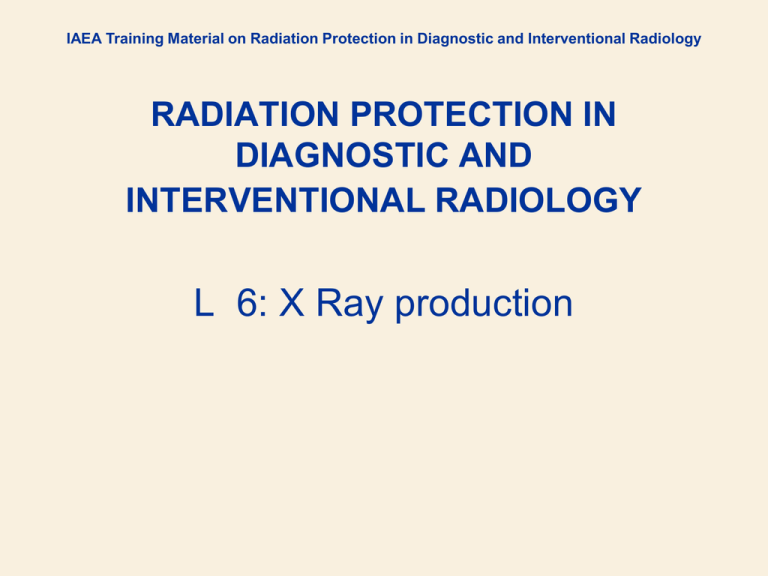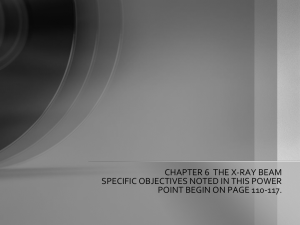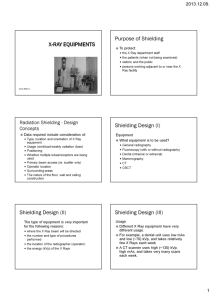RADIATION PROTECTION IN DIAGNOSTIC RADIOLOGY
advertisement

IAEA Training Material on Radiation Protection in Diagnostic and Interventional Radiology RADIATION PROTECTION IN DIAGNOSTIC AND INTERVENTIONAL RADIOLOGY L 6: X Ray production Basic elements of the X Ray source assembly • Generator : power circuit supplying the required potential to the X Ray tube • X Ray tube and collimator: device producing the X Ray beam 6: X Ray production 2 X Ray tubes 6: X Ray production 3 X Ray tube components • Cathode: heated filament which is the source of the electron beam directed towards the anode • tungsten filament • Anode (stationary or rotating): impacted by electrons, emits X Rays • Metal tube housing surrounding glass (or metal) X Ray tube (electrons are traveling in vacuum) • Shielding material (protection against scattered radiation) 6: X Ray production 4 X Ray tube components housing 1: mark of focal spot cathode 1: long tungsten filament 2 : short tungsten filament 3 : real size cathode 6: X Ray production 5 Cathode structure (I) • • Cathode includes filament(s) and associated circuitry • tungsten material : preferred because of its high melting point (3370°C) • slow filament evaporation • no arcing • minimum deposit of W on glass envelope To reduce evaporation the emission temperature of the cathode is reached just before the exposure • in stand-by, temperature is kept at ± 1500°C so that 2700°C emission temperature can be reached within a second 6: X Ray production 6 Cathode structure (I) • • Modern tubes have two filaments • • a long one : higher current/lower resolution a short one : lower current/higher resolution Coulomb interaction makes the electron beam divergent on the travel to the anode • • • lack of electrons producing X Rays larger area of target used focal spot increased lower image resolution Focalisation of electrons is crucial ! 6: X Ray production 7 X Ray tube characteristics • Anode mechanical constraints • • • • Material : tungsten, rhenium, molybdenum, graphite Focal spot : surface of anode impacted by electrons Anode angle Disk and annular track diameter (rotation frequency from 3,000 to 10,000 revolutions/minute) • Thickness mass and material (volume) heat capacity • Anode thermal constraints • Instantaneous power load (heat unit) • Heat loading time curve • Cooling time curve 6: X Ray production Anode angle (I) • The Line-Focus principle • • • Anode target plate has a shape that is more rectangular or ellipsoidal than circular • the shape depends on : • filament size and shape • focusing cup’s and potential • distance between cathode and anode Image resolution requires a small focal spot Heat dissipation requires a large spot • This conflict is solved by slanting the target face 6: X Ray production 9 Anode characteristic 1 : anode track 2 : anode track 6: X Ray production 10 Induction motor • Works on the principle similar to the transformer. • Electromagnetic induction. • Current flowing in the stator develops a magnetic field. • Stator windings are sequentially energized so that the induced magnetic field rotates on the axis of the stator. • This causes the rotor to rotate. Line focus principle • The area of the x-ray tube anode from which the x-ray photons are emitted. • This is called the actual focal spot Anode angle (II) Angle Incident electron beam width ‘ Angle Actual focal spot size Incident electron beam width Apparent focal spot size Actual focal spot size Increased apparent focal spot size Film Film THE SMALLER THE ANGLE THE BETTER THE RESOLUTION 6: X Ray production 13 Line focus principle • Was incorporated into xray tube targets to allow a large area for heating while maintaining a small focal spot. • The effective focal spot is the area projected onto the patient and film. Line focus principle • Focal spot sizes always make reference to the effective focal spot. • The lower the target angle, the smaller the effective focal spot size. Line focus principle • The advantage of the line-focus principle is that it provides the detail of a small focal spot while allowing a large amount of heat dissipation. Line focus principle • The unfortunate bi-product of the line-focus principle is the “anode heel effect” Anode heel effect • Construction phenomenon that causes the x-ray photons exiting the tube on the cathode side to have a greater energy value than those exiting the tube on the anode side. Anode heel effect • More energy absorption occurs at the anode heel resulting in less energy value from the incident photons at the anode heel. • This is used to advantage when imaging anatomical parts that are unequal in thickness and densities throughout their respective lengths. Using the anode heel effect • The following anatomical parts may be imaged using the anode heel effect: • Thoracic vertebrae • Humerus • Femur • Tibia & fibula • Forearm Anode heel effect (I) • Anode angle (from 7° to 20°) induces a variation of the X Ray output in the plane comprising the anode-cathode axis • Absorption by anode of X photons with low emission angle • The magnitude of influence of the heel effect on the image depends on factors such as : • anode angle • size of film • focus to film distance • Anode aging increases heel effect 6: X Ray production 21 Anode heel effect (II) • The heel effect is not always a negative factor • It can be used to compensate for different attenuation through parts of the body • For example: • thoracic spine (thicker part of the patient towards the cathode side of the tube) • mammography 6: X Ray production 22 Focal spot size and imaging geometry • Focal spot finite size image unsharpened • Improving sharpness small focal spot size • For mammography focal spot size 0.4 mm nominal • Small focal spot size reduced tube output (longer exposure time) • Large focal spot allows high output (shorter exposure time) • Balance depends on organ movement (fast moving organs may require larger focus) 6: X Ray production 23 X-ray generator (I) It supplies the X-ray tube with : Current to heat the cathode filament Potential to accelerate electrons Automatic control of exposure (power application time) Energy supply 1000 X-ray beam energy (of which 99.9% is dissipated as thermal energy) 6: X Ray production 24 X-ray generator (II) • Generator characteristics have a strong influence on the contrast and sharpness of the radiographic image • The motion unsharpness can be greatly reduced by a generator allowing an exposure time as short as achievable • Since the dose at the image plane can be expressed as: D = k0 . Un . I . T • U: peak voltage (kV) • I: mean current (mA) • T: exposure time (ms) • n: ranging from about 1.5 to 3 6: X Ray production 25 Tube potential wave form (I) • Conventional generators • • • • single 1-pulse (dental and some mobile systems) single 2-pulse (double rectification) three 6-pulse three 12-pulse • Constant potential generators (CP) • HF generators (use of DC choppers to convert 50Hz mains into voltages with frequencies in the kHz range) “Inverter technology” 6: X Ray production 26 Tube potential wave form (II) Single phase single pulse kV ripple (%) 100% Single phase 2-pulse 13% Three phase 6-pulse 4% Three phase 12-pulse Line voltage 0.01 s 0.02 s 6: X Ray production 27 The choice of the number of pulses (I) • Single pulse : low power (<2 kW) • 2-pulse : low and medium power • 6-pulse : uses 3-phase mains, medium and high power (manual or automatic compensation for voltage drop) • 12-pulse : uses two shifted 3-phase system, high power up to 150 kW 6: X Ray production 28 The choice of the number of pulses (II) • CP : eliminates any changes of voltage or tube current • high voltage regulators can control the voltage AND switch on and off the exposure • voltage can be switched on at any moment (temporal resolution) • kV ripple <2% thus providing low patient exposure • HF : combines the advantages of constant potential and conventional generator • reproducibility and consistency of tube voltage • high frame rate possible 6: X Ray production 29 Automatic exposure control • Optimal choice of technical parameters in order to avoid repeated exposures (kV, mA) • Radiation detector behind (or in front of) the film cassette (with due correction) • Exposure is terminated when the required dose has been integrated • Compensation for kVp at a given thickness • Compensation for thickness at a given kVp 6: X Ray production 30 Automatic exposure control X Ray tube Collimator Beam Soft Air tissue Bone Patient Table Grid AEC detectors Cassette 6: X Ray production 31 X-ray equipment operation mode and application (II) Radiography and Tomography • Single and 3 generators (inverter technology) • output : 30 kW at 0.3 focus spot size • output : 50 - 70 kW at 1.0 focus spot size • selection of kV and mAs , AEC Radiography and Fluoroscopy • Under couch equipment, three generator (inverter technology) - continuous output of 300 - 500 W • • • • output : 50 kW at 1.0 focus size for spot film output : 30 kW at 0.6 for fluoroscopy (high resolution) priority given to contrast automatic settings of kV 6: X Ray production 32 X-Ray equipment operation mode and application (III) • Radiography and Fluoroscopy • Over couch equipment, three phase generator (inverter technology) - continuous output of at least 500 W • • • • output : 40 kW @ 0.6 focus size for spot film output : 70 kW @ 1.0 for fluoroscopy (high resolution) priority given to contrast automatic settings of kV • Cardiac angiography • Three phase generator - continuous output 1kW • output : 30 kW @ 0.4 focus size • output : 80 kW @ 0.8 focus size • frame rate : up to 120 fr/s 6: X Ray production 33 Protective housing Protective housing • X-ray tube is always mounted inside a leadlined protective housing that is designed to: • Prevent excessive radiation exposure. • Prevent electric shock to the patient and operator (technologist). Protective housing • Incorporates specially designed high-voltage • • • • receptacles. Provides mechanical support for the x-ray tube and protects it from damage. Some tube housings contain oil in which the tube is bathed. Some tube housings contain a cooling fan to aircool the tube. When properly designed, they reduce the level of leakage radiation to less than 100 mR/hr at 1 meter when operated at maximum conditions.






